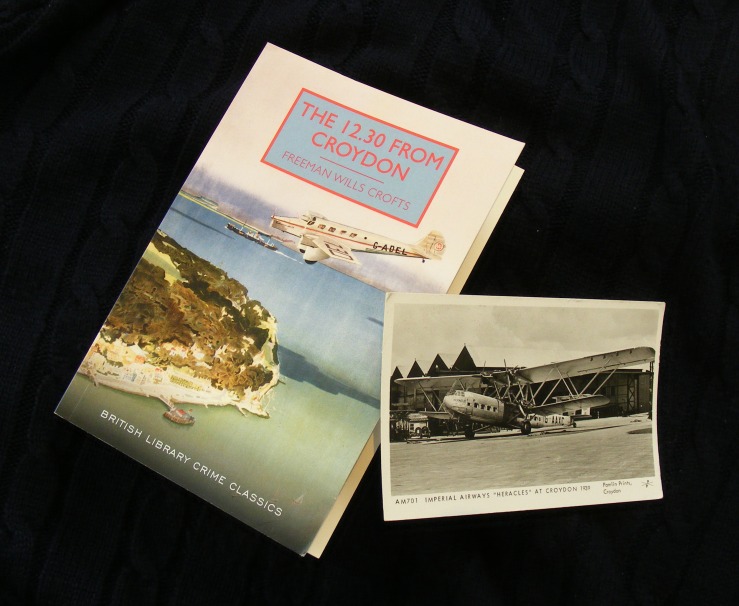
The blurb
We begin with a body. Andrew Crowther, a wealthy retired manufacturer, is found dead in his seat on the 12.30 flight from Croydon to Paris. Rather less orthodox is the ensuing flashback in which we live with the killer at every stage, from the first thoughts of murder to the strains and stresses of living with its execution. Seen from the criminal’s perspective, a mild-mannered Inspector by the name of French is simply another character who needs to be dealt with.
This is an unconventional yet gripping story of intrigue, betrayal, obsession, justification and self-delusion. And will the killer get away with it?
The author
Freeman Wills Crofts (1879-1957) was one of the pre-eminent writers in the golden age of British crime fiction. He was the author of more than thirty detective novels, and was greatly acclaimed by peers such as Agatha Christie and Raymond Chandler.
The publisher
The British Library publishes a range of books – some to tie in with their exhibitions, some just to stock their shop. This is one of their Crime Classics series – reprints of Golden Age detective fiction.
The bookshop
This came, very properly, from the shop at the British Library itself. You get one book free with British Library membership, and this was my choice.
The bingo card
Not so many options as usual here. ‘Genre fiction’, of course. ‘Book from a series’ – Inspector French appears in other books by Crofts. And I think there’s an argument that it defies its own genre.
My thoughts
I must begin by saying that it is sheer good luck that I happen to have a postcard of the sister aircraft of the one that appears in this book, at Croydon aerodrome. I may be something of a nerd about transport in books, but planes aren’t so much my thing, and this is probably the only postcard of one that I possess.
I can’t resist quoting the description, which really is very accurate:
How huge it looked! Unwieldy too, thought Rose, gazing at the criss-cross struts connecting its wings and its long, slightly curved body. Not in the least like a bird, but still like something she had seen. What was it? She remembered: it was a dragonfly. It was just a huge dragonfly with a specially long head, which projected far forward before the wings like an enormous snout. And those four lumps were its motors, two on each wing, set into the front edge of the wing and with its great propeller twirling in front of it. And there was its name, painted on its head: H, E, N, G, I, S, T; HENGIST…
[she boards the plane with her father, grandfather, and her grandfather’s manservant]
The principal object in the landscape was the lower wing. It seemed simply huge from so close. From it the great criss-crosses went up to the upper wing, which she could see only by bending down and gazing up. Others of these criss-crosses went down to the landing-wheel which had a pneumatic tyre a good deal bigger than her whole body.
The postcard came from my godfather, and I think I’d better send the book on to him.
Wikipedia has another picture of Heracles, and one of Helena.
(So yes, the image on the book cover is wrong. It isn’t even a biplane. I’ve seen worse, though: those planes on the audiobook cover of Susan Lanigan’s White Feathers definitely aren’t Sopwith Camels… I’ve heard that it’s very rare for cover designers to be expected to read the book they’re designing for, and that authors have little control over what their books look like.)
Anyway, that’s more plane-spotting than the book calls for, because it’s only the first chapter that really deals with it. This really is a most unusual crime novel: from the child’s breathless perspective on the aeroplane journey (Rose is ten) we abandon her altogether and jump back to the point where the idea of murder enters the murderer’s head. That isn’t really a spoiler: we know about his motive, his means, and his opportunity as soon as he does, and we follow him all the way. Then the detective gets two chapters at the end to expound upon how he worked things out.
Crofts pulls off the rather remarkable feat of telling us everything but never letting it become dull. There are always enough questions left unanswered to keep the pages turning.
The detail is meticulous but again, it’s absorbing. I particularly enjoyed the travel sections within the narrative: apart from the flight to Paris, there’s a Mediterranean cruise that also has some lush descriptions despite the point of view character’s preoccupation:
In the harbour the view was obscured by piers and buildings and shipping. But just before they entered they got a magnificent panorama of the whole coast. To the left was the hill and cape of Posilipo, with its palms and olives and cypresses, screening the fine villas of the wealthy Neapolitans. In front was the city, stretching up to the heights behind, from this distance white and fair. Then to the right the great double-coned mass of Vesuvius rose, with its almost solid column of smoke thrusting fiercely up into the blue sky. It somehow suggested power, that column, white in the mass, but flecked at intervals with the yellow of sulphur and the red of flame. It poured up in seething eddies, gradually bending over as it rose and shifting slowly inland. Beyond Vesuvius the long line of the Sorrento peninsula stretched into the sea, with, farther out, dead astern as they circled into the harbour, the high, jagged outlines of the island of Capri.
Not your average mystery novel, and all the better for it.

Reblogged this on LIVING THE DREAM.
LikeLike